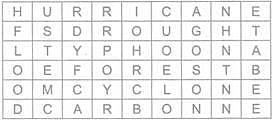Test: Environment And Its Conversation - 1 - Class 5 MCQ
10 Questions MCQ Test - Test: Environment And Its Conversation - 1
Coal, natural gas, petrol, and diesel are a source of ______.
Which of the following statements is correct?
| 1 Crore+ students have signed up on EduRev. Have you? Download the App |
Raju, a farmer gets his field checked for soil toxicity. The report shows high level of toxic chemicals in his field. How can these toxic chemicals in the soil harm?
Saving electricity is the need of the hour. We can save electricity by
Read the given paragraph. As there is more and more _____(i)_____. We are constructing taller buildings, factories and roads. This continuous process of building results in _____(ii)_____ of large quantities of waste formed by it in the landfill areas. Select the option which correctly fills up the blanks.
When lava cools quickly on the Earth's surface, it forms 'X'. 'X' is a very light rock used as a body scrubber and to polish floors. Identify 'X' in the above given paragraph.
Ruchi noticed a major problem in her state. She found that more and more land area in her state is turning into a desert. What is this condition called?
Match column I with column II and select the correct option from the given codes.

Which of the following gases can be produced from locally available raw materials such as recycled waste dung and is a renewable energy source like solar and wind energy?
Rearrange the jumbled words to find out the name of a natural disaster which is not present in the given word grid.


















